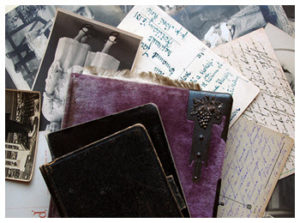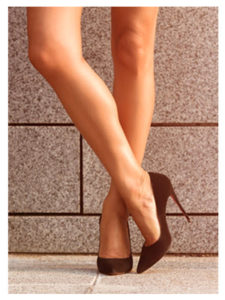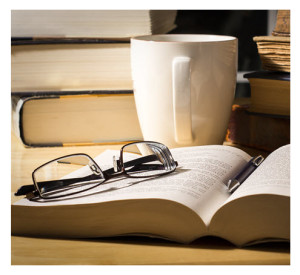Ah… “shedding.” It seems to me that I’ve been attacking that process for years — though chipping away is probably a more accurate representation of how well (or not so well) I’ve managed. I’ve certainly made progress, but I still wonder why I can’t seem to do more, shed more, streamline more easily.
 Maybe I need a new slant, a new motivation, or just a new word. Curating.
Maybe I need a new slant, a new motivation, or just a new word. Curating.
I am well aware that objects are, to me, emotional markers that house memories. As such, ridding myself of what I no longer need feels like loss, like purposely pouring away a rich, textured, and comforting store of life experience. That concept, at moments, leaves me bereft.
On the other hand, there is tangible lightness in reducing papers and possessions of all sorts — certainly a benefit logistically, should you want or need to relocate. I found that out in a very real way not so long ago when I sold my little home and moved hundreds of miles away. But…
While my shedding dilemma has produced assorted projects (and minor progress) for years, and the “big move” resulted in significant donating, giving away, and a small amount of selling off… I nevertheless know that I didn’t shed enough, I wish to be lighter still, I will likely move again in the next year or two, and I continue to grapple with the conflicting and opposite fantasies of throwing out 80% of my “stuff” and boxing that same 80% in airtight containers, carefully labeled, and stacked in a giant storage closet.
An interesting opinion piece in the New York Times addresses this subject and, possibly, offers a new twist that could ease my resistance to additional divestiture. In other words — trashing things no one but me would want.
Rather than using the term shedding, “The Museum of You Doesn’t Have a Gift Shop” refers to curating. Much as one would selectively organize and display objects or art for an exhibition, curating the bits and pieces of our own history may be more than euphemism; it may enable us — okay, me — to select the photographs, journals, letters, scrapbooks, mementos, old clothes, and other fragments of our past.
In her Times article, psychiatrist Anna Fels writes of a patient seemingly unable to throw anything out:
When asked about this habit, he said, “Hoarding is for those without money. For those with money it’s called collecting.” Then, more seriously, he added, “Aren’t we’re talking about throwing out my life?”
Dr. Fels goes on to ruminate about her own possessions, including journals from childhood, the self she can find in them, the challenges of cleaning out or simply reducing the load of belongings for an aging parent — when moving them out of too large a home, for example — and the mixed feelings involved for so many of us in a cultural mindset of keeping, promoting, and documenting… ourselves.
 To an extent, the fact that we increasingly memorialize our experiences through digital means reduces the amount of physical “stuff” we have… theoretically. I say theoretically for obvious reasons; we are a commercial culture, constantly replacing what we shed, encouraged to replace what we shed, buying the latest new thing, and falling for the sale item that pops up on our devices at just the right (vulnerable?) moment.
To an extent, the fact that we increasingly memorialize our experiences through digital means reduces the amount of physical “stuff” we have… theoretically. I say theoretically for obvious reasons; we are a commercial culture, constantly replacing what we shed, encouraged to replace what we shed, buying the latest new thing, and falling for the sale item that pops up on our devices at just the right (vulnerable?) moment.
Much as I acquire relatively little these days, I am hardly an innocent. I am not immune to the one-day sale, the seasonal sale, the monumental mark-down… especially if we’re talking shoes!
Footwear aside, my dilemma is this. Not only do drawings, books, clippings, photographs, postcards, journals, a handful of antique dolls and (an abundance of) shoes sit in cartons stacked in the basement, or accessible in closets and drawers, but when I visit these objects that mark my life, they also mark the lives of those who I was with — often people I loved who are now gone — especially parents and grandparents.
I have become the keeper of family history, of family mementos, of objects that tell the stories of the generations that came before. So I am the guardian of the museum of their lives, in a very small way, which feels important to me — on behalf of my children.
Excuses? Possibly. Sentimentality? No doubt.
Psychologically speaking, one might wonder if hanging on to “stuff” — no, not hoarding — is fundamentally about issues of loss, love, memory, insecurity, or resistance to facing mortality. But maybe it is simpler than that. Maybe it is celebration of wonderful times. And maybe we enjoy our stuff, we are comforted by it, and we are energized by the objects of our “more” that others would have us transform into “less.”
Dr. Fels continues with this bittersweet observation:
When we discard a person’s accumulated possessions, we are throwing out the record of a life.
Maybe yes, maybe no, maybe sort of. Is this all the more reason to curate — selectively retaining in place of lavishly explaining?
I was once very skilled at curating artworks for presentation of an artist’s output. Could I do the same for myself over time? Could I be just ruthless enough to give away what is still good so it is reused, to discard more, and to reduce what remains?
The size 2 clothes I can’t wear — sure. The books? Tougher. My children’s drawings and craft projects? That’s tough, too, though I’ve tossed more than my kids realize.
Photographs? Old letters? Old love letters? I don’t think so. My mother’s boxes of costume jewelry from 50 years ago? These are trinkets that are so her, and for all the challenges in our relationship, I just can’t throw them away.
Perhaps my “Museum of Me” needs a gift shop after all. You know the saying. One (wo)man’s trash is another (wo)man’s treasure…
You May Also Enjoy

Wonderful thoughts, DA! I love this and the practicality of curating our space. Things I tend to keep: journals (yes, even from childhood), jewelry, meaningful books, artwork.
One thing I attempt when faced with overload is to choose something representative of the person. For example, when helping to clean out the home after my grandparents passing, I couldn’t keep or transport all that I would have liked. So I chose several items that made me feel connected to them: a recipe box, an art deco vase, some jewelry. These items could become part of my own home and space. While no one else might notice, they remind me of people that I love and in that way serve great purpose.
Wise words, Missy. And it sounds like you made perfect selections to remember your grandmother by. Doesn’t it make you smile to see something that reminds you of a person you loved?
Yes, I smile every time that I use one of her things.
I’ve been “curating” for the past eight years, and every season it gets easier. Since I simplified my wardrobe with regard to color, I’ve been able to part with things I seldom wore, or thought I’d definitely wear one day. With regard to my shoe addiction, I recently decided to try on every pair and walk around the room a bit. I discovered that many were no longer comfortable, which made parting with them regretful, but necessary.
Though I enjoy the feeling and space of less, curating art and books seems impossible…but then, there’s always tomorrow.
Excellent solution on the shoes, Angela. I will probably take a page out of your book on that one. And then keep the book… ?
“Objects are…. emotional objects that house memories”. That helps me understand a phenomenon I’m not subject to, generally speaking.
I don’t need a lot of possessions, so I don’t accumulate many, and thus have a very hard time relating to those who like to have a lot of stuff just to have stuff, or as sort of a security blanket. But keeping things for their emotional value makes sense, especially since it ties to things I know about psychology. When my father died I asked my mother if I could have a couple of his shirts which were particularly representative of what he typically wore. Seventeen years later they are still in a visible position in my closet as a tangible reminder of him.
My mother would have been very happy for me to take the thirteen bowling balls we eventually found squirreled away in the house (also very representative of him) but I was able to let those go without regret. She gives me lists of audio books to download for her, which I keep. Even though she is nearly blind and has arthritis, she still has beautiful handwriting, which I know will eventually mean even more to me than it does now.
Part of the problem with shedding is finding a viable recipient or avenue of recycling. It is hard to find the appropriate friend to give things to, which leaves selling, freecycling, charity donations, recycling, or the dump. But who has time to sell, or the desire to deal with the unknowns of the public? Things of moderate value I give to charity, but sometimes I wonder if my donation will be an albatross, even to them. And for lesser items, even the recycling centers and disposal sites are sometimes picky. I know, I know, first world problem… I should be grateful to have it.
Finding that viable recipient, as you say, can be more of a challenge than we would think. And it is so hard to simply throw in a dumpster things that you know have value or can be reused. So, first world problem or not, I hear you on that one, Robert.
I AM A COLLECTOR.
IT MAKES ME HAPPY.
I SURROUND MYSELF WITH BEAUTIFUL STUFF THAT KNOW ONE ELSE WANTS.
I GIVE IT A HOME.
A WELL WORN HOME.
THE ANIMALS AND I sway through the taffeta draped tables and velvet backed frames to get to the kitchen where rugs, chairs and love seats await us! If YOU TAKE THAT AWAY FROM ME YOU MIGHT AS WELL PUT ME IN A BOX!
LIVE WITH THE STUFF THAT MAKES YOU HAPPY!
XX
D.A.,
First of all, thanks for including the column from the NYT with your essay. I find this topic very interesting along with the variety of comments! How you ended your essay gave me a smile. ?
I just ran across a book and article that perfectly encapsulates many of the issues involved in this. The book, Gentle Art of Swedish Death Cleaning, talks about how to declutter starting in midlife so as to leave nothing for your relatives to deal with, and how to navigate the deciding of what to keep.
The article is here.
The book’s author takes a similar philosophical approach to the “curating” concept – “Death cleaning isn’t the story of death and its slow, ungainly inevitability. But rather the story of life, your life, the good memories and the bad. ‘The good ones you keep,’ Magnusson says. ‘The bad you expunge.'” You then reward yourself by doing something which enhances your joy in the present moment (but doesn’t involved buying more “stuff”).